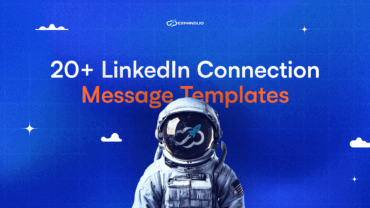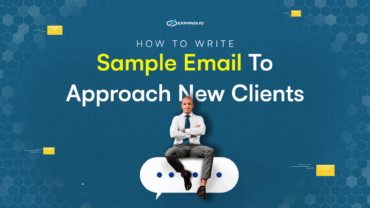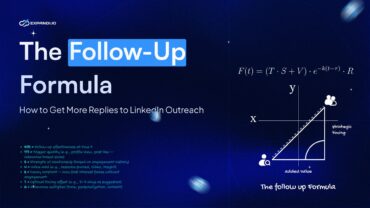5 Follow-up Email Templates That Reduce Sales Anxiety – Expandi
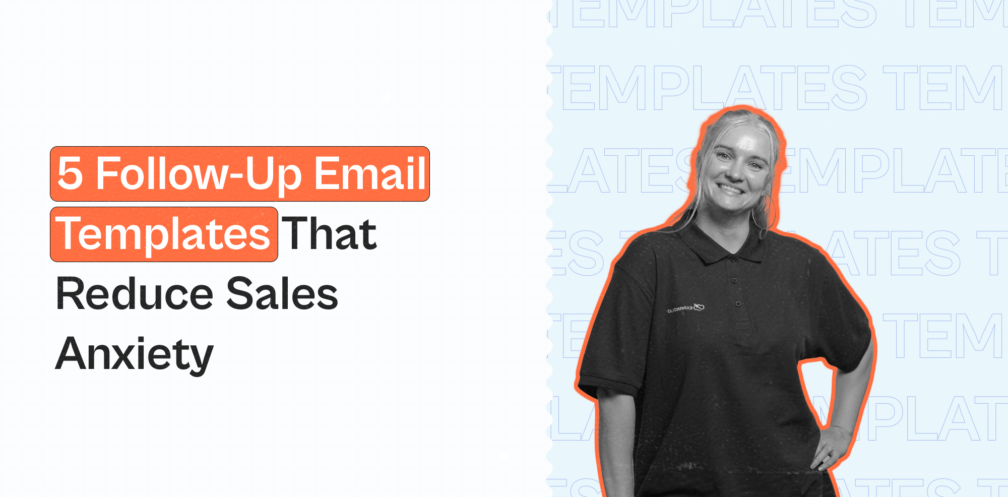
If you’re not following up, you’re leaving a lot of money on the table.
Simple as that.
According to IRC Sales Solutions, 44% of salespeople give up after just one follow-up attempt.
Meanwhile, the statistics will be in your favor if you follow up. Consider that:
- 60% of customers say no four times before saying yes.
- You increase your average reply rate to around 13%
- Campaigns with so many as one follow-up convert about 22% more prospects than the one without any.
And if you’re wondering how many times should you follow up, the rule of thumb says the magic number is a minimum of 5 emails – spread across weeks.
All this to say:
If you’re following up, statistically, you’re increasing your chances to convert the lead.
There’s no reason not to!
And the bright side is that follow-up emails are NOT as time-consuming as you might have thought.
They require no personalization for the most part, and you can simply copy the email templates you’re about to see below.
Then, plug them in your favorite email outreach tool and you’re good to go!
Here’s what you’ll learn:
- How To Write A Sales Follow Up Email And What to Include In It
- How to Write a Convincing Follow Up Email That Compels Your Leads to Take Action
- 5 Top Follow Up Email Templates and Examples to Close Deals
Now, let’s get started.
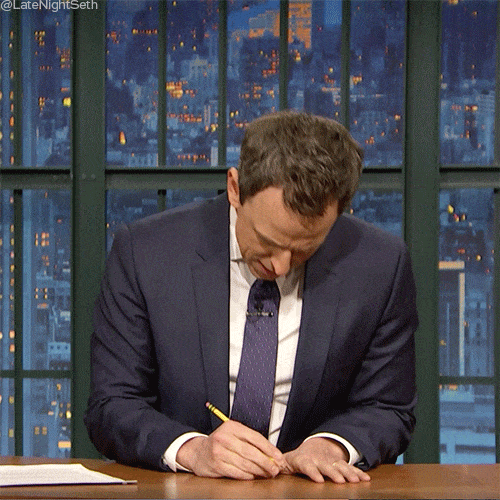
How To Write A Sales Follow Up Email And What to Include In It
Now, if you’re reading this, chances are, you already know how to start an email and find your target audience.
But if you want your follow-up emails to hit, instead of simply annoying your prospects, let’s go over some essential email elements you should include when doing outreach.
The more you know about your prospect, the better your follow ups will be.
So, here’s what you need to know.
Staple email sequence outreach elements
It’s worth going over this anyway, because, while we could simply write up the templates here and call it a day, every industry is different.
So, to make the most out of the templates below, you’ll want to go over this checklist and make sure your emails are up to par in the first place.
Your email follow-up won’t work as well if your original email isn’t very convincing in the first place.
With that said, here are some conversion-driven elements you’ll want to be included in your email sequences:
- A strong hook – If your email doesn’t stand out in the first place, it’s going to be hard to get your prospects to read the rest of the email, let alone take action.
- Personalization – This works in every industry. It can be time-consuming, but it’s absolutely effective and worth it. Here, you’ll need to show your prospect that the email was written specifically for them, by mentioning something so unique it wouldn’t work for any other lead.
- Relevant value proposal – This is a case of targeting the right audience. And even then, you’ll want to keep your emails relevant. For example, if you’re targeting Fortune 500 CEOs, chances are, they don’t like their time being wasted, so you should get to the point.
- 1-2 Sentence case study – You don’t have a lot of real estate in an email if you want to show off your expertise. Try to keep this short and succinct, using relevant data and numbers.
- Call-to-action (CTA) – Finally, if your email doesn’t end with a specific CTA, your leads will not know what to do and resort to doing nothing. Try to give them a few choices, so they don’t procrastinate and put off replying for later!
Now, you could combine these elements into a template and come out with a strong email.
Check out our full guide to email sequence outreach to learn how to do that.
Below, we’ll teach you how to craft the perfect follow-up email to avoid the dread for selling and closing deals!
How to Write a Convincing Follow Up Email That Compels Your Leads to Take Action
Here, we’ll be breaking down the anatomy of a follow-up email.
Let’s start from the top.
Follow up email subject lines
Now, one common question in sales outreach is: “Should I follow up in the same email thread or create a new chain?”
And the short answer is to follow up in the same email chain so that your leads have a reference to your original pitch or product details. This is what we recommend most of the time, if you’re creating sales sequence outreach campaigns.
If, however, you want to simply remind them about a call or give a quick update, you’ll want to follow up with a new email, which would require a new subject line.
Here is a sample of what some cold email subject lines might look like:
- Quick question, {first_name}.
- Hey (first-name), just kidding {first_name}!
- quick question on (topic)
- Question for {company_name}
As you can see, they’re very simple and straightforward.
Now, here’s what email subject lines might look like for a new email chain follow up:
- About our next step
- Do you mind providing me with some feedback?
- Resources I mentioned
- Form to move forward
In this case, the subject lines are very contextual, based on what your next step with the lead is.
Follow up email openers
As you might have guessed, starting your follow-up email is different than your regular email.
Here are some strong hooks you can use or modify:
- Just wanted to follow up on (topic)…
- Have you had the chance to look at my previous proposal, {first_name}?
- In case you missed my email last week, wanted to bump this in your inbox!
- Your colleague mentioned I should reach out to you…
But if you really want your follow-up to elicit a reply, there are some conversion-driven elements you can include as well.
These will be more effective than simply reminding your prospect to reply!
What to include in your email follow-ups to drive action
Following this technique, you’ll be using your follow-ups to move your prospects 1 step closer to wanting to work with you.
So, instead of simply reminding them about your existence, you can use this opportunity to remind them about your expertise and authority instead.
Think of your email follow-ups as an additional sales sequence.
So, the email follow-up sequence might look like this:
- Regular follow-up.
- Personalized follow-up question.
- Client win / case study.
- Injecting humor to stand out.
- No interest / future follow up.
Let’s take a look at some examples!
Bump follow up
- Hey {first_name}, just wanted to bump this in your inbox.
- Hi {first_name}, understand you’re busy, let me know if you’re interested in this?
Personalized follow-up question
- Hey {first_name}, saw your case study on LinkedIn! Great job, quick question…
- Hi {first_name}, read your recent blog post on omnichannel customer experience, have you considered…
Client win / case study
- Hey {first_name}, just wanted to let you know about a quick win we had with our client and how we managed to help them book 40+ calls in 1 week.
- Hi {first_name}, was just wondering if you’re using omnichannel outreach at (company_name)? We managed to help a client close 61% more demo calls using…
Injecting humor to stand out.
- I know I’ve been talking to myself this whole time, but if you’re out there…
- Before I send out a search party, {first_name}, I wanted to share with you…
No interest/future follow-up.
- I appreciate how busy you are. Would you please let me know which number relates to you? 1 – I’m interested but just isn’t the right time, follow up in 2 weeks. 2 – Not interested leave me alone
- Hey {first_name}, our schedule might be full next month. Let me know if you’re not interested or if you want me to follow up in the future?
Now, putting all this together, it’s easy to come up with follow-up email templates from scratch.
But to make things even easier, let’s take a look at some ready-to-go email templates and examples you can use for inspiration below!
5 Top Follow-Up Email Templates and Examples to Close Deals
These emails use most of the best practices we covered above.
With some modification, you can use them as inspiration to craft your own follow-up emails or use them as they are, assuming they fit your industry.
But if you’re looking for templates for LinkedIn, be sure to check out our LinkedIn cold message templates that get a ~49% reply rate too.
Note: If you’re not sure when to follow up, spread it across some time so that you’re giving your prospects space to breathe. Don’t follow up on Fridays or the Weekends, and test to see what works for you. Most people follow up within 4-9-15 day delays.
Now, let’s get started.
1. Follow up sample email after no response
“Hey {first_name},
Not sure if you saw my last email, so, I'm going to make this one quick to not waste your time.
I'm confident a collaboration between {{company_name}} and (your company) is a win-win situation. Here’s why:
Argument 1.
Argument 2.
Argument 3.
Let me know if you'd be open to a quick, 10-minute call any time on Wednesday or Thursday.”
2. Post-meeting email follow up
Subject line: Next steps
“Hey {first_name},
Was great talking to you about sales outreach!
As promised, here’s the follow-up and next steps:
(describing next steps).
To make things quick and easy, here’s a link to our Airtable form you can fill out and get started!”
3. Post webinar email follow up
Subject line: Cheers, {first_name}
“Here’s to you {first_name}!
I just had to pop open the champagne when I was your name on the list of attendees from our yesterday’s LinkedIn best practices webinar.
Let me know if you have any questions or if there’s anything I can help you with at all to get started.
See you soon!”
4. Sales email follow up
“Hey {first_name},
I noticed I didn't get a reply to my email 5 days ago, which leaves me no other choice…
I've prepared a 5-minute audit for {company_name} on how to boost your outreach and sales sequences, check it out below:
[URL]”
5. Post LinkedIn connection email follow up
The goal of this email is to follow up with a prospect after connecting with them on LinkedIn, which you can do automatically, see how below.
Learn how to create automated omnichannel follow-ups and hyper-personalized GIFs here: The Power Of GIF Animations And Hyper-Personalization In Your LinkedIn Messaging: Skyrocket Your Reply Rate Up to 55%
Conclusion
Hope this guide to email follow-up templates helps reduce the dread for selling and closing deals in your next outreach campaigns!
To sum up, let’s go over some of the top questions on the topic:
- How do you write a follow-up email?
The general goal of a follow-up email is to get your prospect to reply. But instead of simply reminding your prospect about your email, you can use the following follow up sequence to establish your authority and stand out as well:
- Regular follow-up.
- Personalized follow-up question.
- Client win/case study.
- Injecting humor to stand out.
- No interest/future follow-up.
- How do you write a follow-up email after no response?
If you haven’t received any response to your original email, you should be aiming to:
- Add value with each email follow-up.
- Make it short and personalized.
- Include new and relevant information with each new message.
- Personalize it on a high level or use dynamic GIFs to stand out.
- End on a persuasive call-to-action instead of leaving things open for your lead.
- How do you politely follow up request?
44% of salespeople give up after just one follow-up attempt. To politely follow up, respect your prospect’s time and get straight to the point. Make sure your email is relevant and finish with a call-to-action so they know what you want them to do and why it’s important.
- How do you follow up with a busy person?
You never know what your lead is going through or what their schedule is like. So, you should try different things if you want to follow up with a busy person. And if they still haven’t responded, you can follow up on LinkedIn as well!
Wondering how to set up omnichannel outreach sequences so that you’re following up on multiple messaging channels?
With Expandi V2, you can automate your entire marketing funnel!
For more info, be sure to learn that article or get started with a free live demo (or a free 7-day Expandi trial)
You’ve made it all the way down here, take the final step
